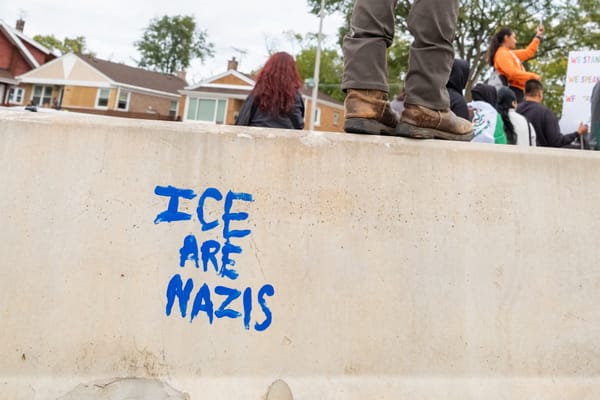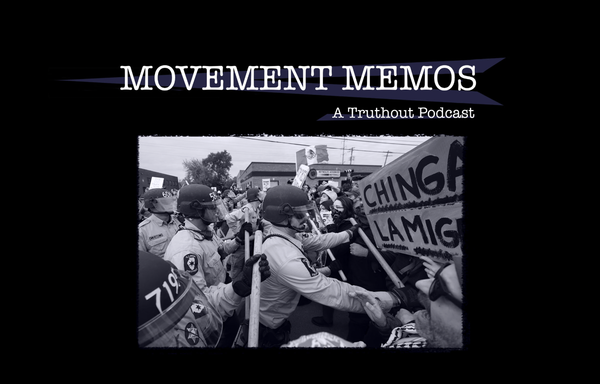Preparing for Election Day Threats Amid Rising Right-Wing Violence
"Electoral safety planning is for everybody, including groups that don't believe in or participate in national elections," says Che Johnson-Long.

The 2024 presidential election is creating major safety concerns for election officials, poll watchers, activists, and marginalized communities. For months, the Department of Homeland Security has been warning election officials nationwide about the potential for right-wing violence on and around Election Day. DHS has flagged efforts by right-wing extremists to incite attacks on election infrastructure, which could include bombing ballot dropboxes, lone-wolf attacks on election facilities, or the assassination of lawmakers. On November 5, 200,000 volunteers from Donald Trump’s campaign will deploy across the country to monitor polling places and “establish the battlefield” for a contested election. These volunteers have been tasked with gathering the “evidence” that was missing during Trump’s previous attempt to overturn the election. Given that Trump, JD Vance, and Trump’s bouncy, billionaire fanboy Elon Musk have been aggressively promoting conspiracy theories about immigrants voting illegally, this surveillance effort will likely target Black and brown people who Trump supporters perceive as foreign. That targeting will almost certainly result in voter intimidation and could lead to violence. Hoaxes about migrant communities, amplified by Donald Trump and JD Vance on the campaign trail, have already resulted in bomb threats against schools, hospitals, and government buildings in Springfield, Ohio. Unfortunately, these threats will not be confined to Election Day, as pro-Trump forces are primed to use lawsuits and new election rules in some states to create delays, sow doubt, and produce spaces of contestation.
The severity of these threats highlights the need for electoral safety planning among movement groups and organizations. To explore these concerns, I recently spoke with Che Johnson-Long, the Community Safety Education Coordinator with Vision Change Win (VCW). Che is a queer community organizer and security practitioner. She develops community safety curricula, coaches left movement organizations and coordinates VCW’s safety and security programmatic offerings.
This interview has been lightly edited for length and clarity.
Kelly Hayes: What is electoral safety planning?
Che Johnson-Long: Honestly, it's not all that different from safety planning. I think any left movement group should be doing some regular assessment of safety threats and then creating protocols that help groups safeguard against those threats. That can mean anything from creating internal protocols about how you share documents and when to developing a safety team whenever you have internally coordinated events. So safety planning in general, I think, is just groups being able to regularly assess risk and then create plans to intervene.
Electoral safety planning means considering that, while we do this regular safety planning, election season creates a unique hodgepodge of threats, and the political landscape changes really rapidly. Threats often get amplified before national elections and sometimes local elections. Electoral safety planning means thinking about the work that you do in relationship to elections, but then also just thinking about the political landscape that we swim in regardless of how you interact with elections.
Groups that do 501(c)(3) and 501(c)(4) work have to consider the ways that compliance laws might impact them and protect their groups from acting out of compliance, which can lead to IRS audits. That means making sure that they're clear on the difference between (c)(3) work and (c)(4) work. For some groups, it means making sure that they have a strong plan for what information canvassers might have access to and then how to remove those access points once they're done canvassing.
I think electoral safety planning is for everybody, including groups that don't believe in or participate in national elections. A more emboldened far-right impacts all of our left movement groups. When there are more counter-protesters at our actions and more threats to verify online, all of our safety plans should take that into account.
Kelly: What are some of the potential threats that organizers are concerned about in the run-up to this election?
Che: We're seeing a lot of targeting of our communities. The GOP has been spending a ton of money to create these targeted ads that are really, I think, trying to create a transphobic political landscape. They’ve spent $17 million to highlight moments when Harris has expressed support for gender-affirming care, and we know what that is, right? We know that it's an attack on Democrats, but more importantly, it's an attack on trans people.
I think these national elections always embolden the far right. We've heard of threats that different far-right groups, like the Proud Boys, are making on their website to target drop boxes and some polling locations. They've been making these threats since the summer, so they're not new, and we saw similar things in 2020.
Voter suppression and election denial can also create safety threats that actually go beyond Election Day or the ballot box. For example, the Georgia Board of Elections, which is Republican-run, has this new rule about Georgia hand-counting ballots, and it's being disputed in court right now. [Author’s Note: Georgia’s hand counting rule has been enjoined by Fulton County Judge Robert McBurney.] In 2020, there was a similar hand-counting rule in Pennsylvania, and there were so many protests organized by people who were seeking to deny the election results. There were so many counter-protesters; there were so many death threats that were made by election deniers because this hand-counting rule created an opening and an opportunity for folks to get targeted. These election denial and voter suppression tactics impact people's voting rights but also can impact community safety more broadly.
We also have to think about police violence. I think that we will definitely see a more substantial police presence at the protests and rallies that happen after Election Day. We're already seeing a huge uptick in political violence more broadly, and I think that police violence at protests will only get more intense if there's a contested election.
Kelly: I really appreciate what you’re saying about how some of these Republican policies are really about manufacturing uncertainty, which creates space for contestation and violence. Wherever they can create delays or confuse the process, they can conjure conspiracies and cast election officials, or particular groups or demographics, as villains who are trying to steal the election.
Che: The more unsure people are, the more strongholds fascists can claim. These far-right groups and other bad actors are really just looking for any political excuse to harm our communities and our movements.
Kelly: In Vision Change Win's Electoral Safety Toolkit, VCW recommends crafting a safety plan six months ahead of a national election. For people who've been engaged in that work, what have those preparations looked like?
Che: A lot of electoral groups have long-standing organizational safety practices. Some of those practices include making sure that they have increased digital security and making sure that the leaders of those organizations are regularly guarding against things like doxxing. So they are using DeleteMe, they are tracking where their personal information is online, and they're intentionally getting rid of information that doesn't need to be spread online.
I think, in a lot of ways, they're just tightening practices that already exist. So again, that means getting really clear about that (c)(3), (c)(4) compliance. We're already seeing a lot of increase around IRS audits, especially amongst Black-led groups and trans-led groups, and so I think that those are the kinds of safety threats that most groups won't feel in November, but they will feel in the following six months, and so making sure that they're clear about separating (c)(3) and (c)(4) work.
I think a lot of 501(c)(3) groups need to make sure that they're extra clear about what's (c)(4) work, getting clear about the difference between endorsing a candidate or even discouraging people publicly from voting for a candidate. That's the kind of stuff that I think a lot of groups in the next six months are going to see a lot of scrutiny from the state about, and we just want to minimize any opportunity for the state to come in and audit a group or prevent them from being able to do the work that they do.
I think for many groups, it's about increasing their situational awareness. That means tracking who attends their rallies, monitoring their social media with a little bit more rigor, documenting weird comments, or noticing folks who are parked outside or weird vans. Some of it is just about communicating when they notice things that might be a little out of the ordinary.
For some groups, I think it's really increasing the rigor around their member vetting, so noticing membership changes. A lot of people will seasonally volunteer at electoral organizations, but also just left-movement groups in general as we get closer to elections. I think it's great whenever we have this influx of volunteers, but people also need to be mindful about how they offer access points to new members or to volunteers, making sure that you're vetting with extra scrutiny for folks who might become member leaders in your group and really keep an eye out for bad actors or potential infiltration.
Kelly: Your group provides a lot of rapid response support to organizers and activists who are facing threats. I have benefitted from that assistance during dangerous times, as have people I have referred to VCW. So, I have a deep appreciation for the work that you all do. Amid all of that work and your ongoing educational programs, what have your electoral safety planning support efforts looked like in 2024?
Che: We built out this electoral safety training program, gosh, almost three years ago, and I think for us, we believe in safety planning early and not waiting till the last minute, because we know that infrastructure building takes time. So whenever we can, we encourage groups to make sure that they're thinking about electoral safety months out from an election. So for us, that means offering our training series, since 2022, training groups and encouraging groups to get trained six or nine months ahead of an election, so that they have enough infrastructure to be prepared for unexpected threats.
We also know that sometimes threats are difficult to plan around, or they just genuinely do surprise us, and so we offer rapid response support, and we've increased that support and also made it public to really try to meet the need, or the anticipated need, I should say. We created an Electoral Safety Toolkit. I find that a lot of groups who are already at low capacity end up experiencing even lower capacity as we get closer to elections. Safety threats are overwhelming, because a lot of groups are already operating with a very small team or with a very small budget, and so the toolkits are a way of making a free offering to folks who want a safety plan, but don't have time to attend a training.
Then I think, more than anything, we've just been really trying to encourage left movement groups, left funders, individual activists, collectives, everyone that we roll with to consider safety threats regardless of whether or not they do direct electoral organizing. I think there are a lot of abolitionists in my world who I love and care about who, for a lot of understandable reasons, have decided not to engage in electoral politics at the national level, and I don't think that insulates them from the safety threats that can get worse during the electoral season. So, if anything gets to the masses from our work, I hope it's that. I hope that all left movement groups are considering the community safety threats that increase during this time and that we're all doing what we can to plan around it. Because our left movement work is too precious, abolition work is too important to not safeguard.
Kelly: Are there any steps or precautions you would recommend for people who have not been engaged in safety planning in recent months, but who are getting worried now about potential threats around the election?
Che: The thing I was saying earlier about situational awareness, I think folks who haven't been planning, but are starting to now, or at least starting to get worried now, I think those groups can also increase their situational awareness at the individual level or at the organizational level.
So individuals should notice if you're getting the same threatening comments on your social media from an account that seems fishy or that seems like a bot, and you should tell other folks that you organize with. The awareness piece is half of it and the other piece is communicating potential safety threats with your comrades and with the folks that you organize with.
At the organizational level, I think a lot of the same things apply. Making sure that you are tracking who comes to your membership meetings, making sure that you're increasing your member vetting practices. I also think there's something about communication discipline that we can all improve on, in terms of stopping the spread of misinformation.
There are so many ways that misinformation is spreading. I recently learned about this effort, funded by Elon Musk, to spread misinformation while impersonating the Harris campaign via text, with messages that send people to a fake website. We need clarity. As left movement folks, organizers, and activists, we need to get clear on when a threat is a verified threat, meaning someone has researched it, they've checked it out, and when it's a rumor. We need to have discipline individually and inside our organizations to not spread threats that are actually rumors, because that can also clog up our communication channels and make it difficult for us to know how to respond or how to prioritize what to respond to.
I think everyone can stand to have an updated emergency contact form that they share not only with their organizing work, but also with the folks who are in their life who are important to them, including their family and friends. Having a plan for an arrest, for a medical emergency, having an emergency contact form that someone can look at if they just haven't heard from you in a few days, who to talk to.
Unfortunately, it's becoming increasingly important, especially for southern organizers, to make an emergency contact plan for climate crisis disasters. So we've seen how the two most recent hurricanes have impacted a lot of folks in the Southeast, and I think some of the hardest pieces of that are just being able to locate people and get a sense of who is already in contact with folks and who is missing.
So if you don't do anything else, just creating an emergency contact form, which can take ten minutes, can mean the difference between us looking for people who are not actually missing and us focusing on folks who might've been arrested without our knowledge, had a medical emergency without our knowledge, or, heaven forbid, have disappeared without our knowledge.
Kelly: That’s great advice. I also think people who still rely on Elon Musk’s social media app for information about movements or politics really need to have contingency plans, especially around Election Day, because that app has become a bullshit chamber that amplifies confusion and misinformation by design. To be reliant on it, when Musk is clearly willing to cross any line for the sake of his fascistic agenda is a bad idea. We need to broaden our networks and broaden our options. I think that’s a safety concern at this point.
Che: Agreed.
Kelly: Circling back to the threat of right-wing violence, I have seen some people on social media dismiss concerns about violence on and around Election Day. People who write off these concerns often assert that Trump supporters are “all talk.” While I obviously hope that nothing violent occurs, I also find these dismissals confusing, given the realities of right-wing violence in the United States. Some people seem to feel that our only options are to cower in fear, assuming that violence is inevitable, or to dismiss the threat entirely. What are your thoughts on how we should approach concerns about violence on and around November 5th?
Che: First, I just want to make space first to say that the cowering or the dismissing, that these responses are understandable in a political climate when many, especially communities of color, especially Black folks, especially trans folks, are under constant attack. So, for a lot of groups, especially groups who are targeted by the state, we've been experiencing safety threats at an increased level for months now. So I just want to name that for a lot of folks, that kind of trauma response or that way that we've responded to harm that's happened to us in the past–these responses are understandable.
I can understand why someone would respond that way, and also, trauma responses do not assess risk well. In some ways, they're kind of like one-trick ponies. A trauma response might replicate one way that I responded to a threat back in 2010, and I might repeat that response in 2024 as if it were 2010. So there's a way that those trauma responses can get us very stuck in time.
So, while I get the trauma responses and I get the ways that people are responding to the right, I also think that we don't have the luxury of time or capacity to waste on not doing thorough risk assessments. So I think that folks should listen to experts, learn how to spot deep fakes, learn how to verify information, and I kind of just think people need to build up their own risk assessment muscle and not just take my word for it. So whenever I'm talking to people about risk assessments, I usually invite folks to look at what's happening at the national level, at the local level, and in their own group's history.
What I'm seeing at the national level is that the Department of Homeland Security has started to reach out to different local agencies about potential attacks, and I think once DHS gets worried enough to start reaching out to local agencies about the far-right, it says something. It says that I think this could be a likely threat. We've already seen verified accounts of the Proud Boys and other bad actors making threats to ballot boxes as far back as May and June, so I can see the threat getting verified at the national level.
At the local level, I think every region is going to experience far-right violence very differently, and so I encourage folks to talk to regional partners, coalitions, and state tables. For folks who aren't clear about where to reach out to, I think folks should look to national groups like the Working Families Party or State Voices, who are doing a lot of coordination with local and statewide tables to get a sense of what is the actual threat to harm.
Then I find a lot of groups, especially groups who are more than five years old, do great work, but they tend to not document safety threats well over time, and so I'm noticing that some of the groups that I'm supporting now in 2024 have experienced attacks in 2020 that they never documented. So, the leaders that are coming to me now actually have no idea that their group experienced death threats from Nazis in their email, or the threat of violence or actual violence at their protests, because they weren't leaders in 2020.
So, for a lot of these groups, the work is to go back to leaders who were around then and make sure that we're talking to folks who came before us about threats they experienced. I'm not just talking about 2020, which is only four years ago. I'm talking about going back to leaders of your group to ask them how they navigated far-right violence and right-wing violence, especially southern organizers who tend to experience a disproportionate amount of that harm and who also tend to be incredibly under-resourced to address the harm.
Safety planning, when it's done well, strengthens our organizations, regardless of the outcome. So, if a bad thing doesn't happen, great, but if I have a strong member vetting practice, then that also means I'm going to have a strong base-building practice and leadership development practice, because those go hand in hand. So when we incorporate these practices into our organizing, it also means that we just have more effective, resilient organizations, which I think is everybody's goal.
Organizing My Thoughts is a reader-supported newsletter. If you appreciate my work, please consider becoming a free or paid subscriber today. There are no paywalls for the essays, reports, interviews, and excerpts published here. However, I could not do this work without the support of readers like you, so if you are able to contribute financially, I would greatly appreciate your help.




